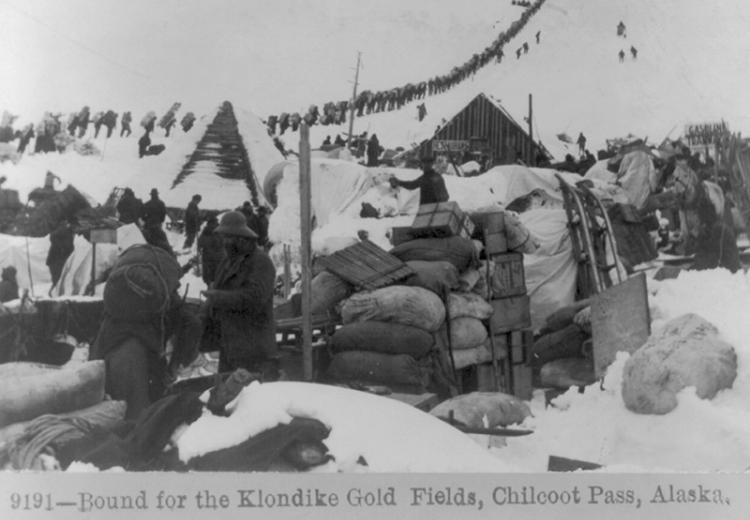Metaphorical Gold: Mining the Gold Rush for Stories

Bound for the Klondike gold fields. Chilkoot Pass, Alaska.
"… the Yukon provided the metaphorical gold for his [Jack London's] first stories…"
—Dr. Clarice Stasz, from The Jack London Collection, a link from the EDSITEment resource The Center for Liberal Arts.
The lure of gold is strong. The first nuggets of the Klondike Stampede were brought into the town of Forty Mile on August 20, 1898. Two days later, the town was deserted, claims were being staked out all around the original site, and the Gold Rush was on! Despite the distance and the difficult conditions, thousands of Americans traveled to the Yukon willing to test their mettle in hopes of striking it rich.
One of those who came to the Klondike was Jack London, soon to be an internationally famous author. What he sought in the Yukon was not gold, however, but rather the adventure and "the metaphorical gold for his first stories." London's experiences in the Yukon provided him not only with an appropriate setting for the life and death struggles he wanted to depict, but also with sufficient local color to lend authenticity to his writing.
By "mining" online databases for primary texts and period photographs, your students can explore the Klondike Stampede, and, like London, can glean from their visit sufficient period details to help them create their own narratives based on the Gold Rush. If time does not permit students to write their own stories, the teacher can select stand-alone sections from this lesson that deal with the history of the Gold Rush era. While the emphasis of this lesson is on history and research rather than literature, selections from Jack London's The Call of the Wild are used to provide focus and structure for students' research in online databases of primary sources, and to serve as models of vivid narrative prose for students' own stories.
Note: Students and teachers who have completed all or parts of this stand-alone lesson and who would like to learn more about Jack London may wish to explore the complementary EDSITEment lesson, Jack London's The Call of the Wild: "Nature Faker"?, which explores in depth how his novel, The Call of the Wild, responds to the technical challenge of writing from an animal's perspective without humanizing or sentimentalizing.
Guiding Questions
What experiences awaited the tens of thousands of hopeful prospectors drawn by the discovery of gold in the Yukon?
How can students use details drawn from their research on primary source materials, and examples drawn from Jack London's vivid narrative prose, to add color and authenticity to their own stories based on the Alaskan Gold Rush era?
Learning Objectives
Relate information about the Klondike/Alaska Gold Rush, describing how Americans traveled to the gold fields and how they fared once they arrived.
Use authentic historical details in their own stories based on the Alaska Gold Rush.
Use Jack London's vivid narrative prose as a model to develop varied sentence structure and length in their own stories.
